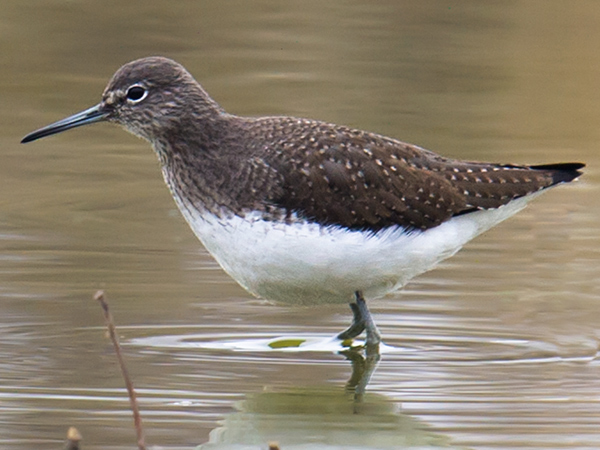by Craig Brelsford
Founder, shanghaibirding.com
Elaine and I noted 85 species at Yancheng, Dongtai, and Yangkou. We reunited with the Dream Team, which includes Senior Birder Michael Grunwell, husband-wife team Stephan Popp and Xueping Popp, my wife Elaine Du, and me. We added evidence that the point 32.557278 121.037111 is a reliable site for Brown-cheeked Rail Rallus indicus, and at Dongtai we found a sub-adult Mute Swan. At Yancheng, we found 9 Red-crowned Crane, 10 Hooded Crane, 250 Common Crane , 2 Oriental Stork, 1250 Common Merganser, and 8 Reed Parrotbill. Among our big finds at Dongtai were 11 Red-breasted Merganser, 14 Greater Scaup, 80 Saunders’s Gull, and 610 Grey Plover. We recorded Pied Avocet, Black-winged Kite, and Smew at Dongtai and Yancheng, and we found Green Sandpiper at Yancheng and Yangkou.

In May 2010, I found Brown-cheeked Rail at the point in Yangkou noted above. I forgot about the sighting and did not search again until last 15 Nov., when I found Brown-cheeked Rail after a 30-minute wait. On Sunday, I made my second of two tries at the site and was successful again.
Using the evidence I have presented here, you may believe, as I do, that the site is reliable for Rallus indicus. If you need the bird, then go with a few more birders if possible, stand in the area shown on the Google Map linked to above, spread out, and pay attention to the edge of the reeds. On Sunday, in contrast to 15 Nov., the rail never showed clearly; only Elaine’s sharp eye confirmed the presence of the scurrying rail. I got a look that first time, and about 30 minutes later, the bird showed again, and everyone got a quick view. The bird was calling softly from time to time and called loudly, but only briefly, when I first played back Water Rail R. aquaticus. (I played back R. aquaticus because the recordings I have of R. indicus are poor.) If you have qualms about playback, then you may still be able to see the bird, but be prepared to wait. If you are lucky, Reed Parrotbill will show; during our wait, we had Pallas’s Reed Bunting, Rustic Bunting, a Common Snipe that was hiding in plain sight, and an unusual winter view of Chinese Pond Heron.

With last weekend’s work at Yancheng, Elaine and I completed a survey (which began last year) of the Jiangsu coast from just north of Yancheng south to the Yangtze. Along that 300 km (186 mi.) stretch of coast, the best place to bird is Dongtai, followed by Yangkou and Yancheng. Besides those three areas, there is little left. There may be pockets that I have overlooked, but I doubt they are substantial; I doubt there is some secret location holding 100,000 waders.
The coastal area of Dongtai city is under no environmental protection that I know of, and in fact is slated to be transformed for aquaculture. At Yancheng, the Red-crowned Crane we saw were shuttling back and forth between fields, with busy farmers, noisy farming machines, and farmhouses never far away. At Yangkou, the smell of chemicals grows ever stronger, just as birdable areas behind the coastal wall grow ever smaller and the invasive Smooth Cordgrass on the mudflats grows ever more extensive.

Jiangsu packs 80 million people into an area less than a quarter the size of Sweden or California. If Sweden were as densely populated as Jiangsu, then its population would be about the same (320 million) as that of the United States. The GPP (gross provincial product) of Jiangsu is one-third the GDP of India. A dense population of people with a culture that cares little for conservation and operates an economic powerhouse: That is Jiangsu. No wonder the Jiangsu coast is being chopped to pieces!
Thanks to Michael for teaching us birding, to Stephan for his excellent driving, to Xueping for her quick mind, and to Elaine for her cheery attitude.




Featured image: L-R: Stephan Popp, Michael Grunwell, & Elaine Du view 1250 Common Merganser near Crane Paradise, Yancheng, Jiangsu, China. (Craig Brelsford)


Dear Shanghai Birding,
I’m planning to go Yancheng Wetland National Nature Reserve Rare Birds in late December 2023. I’m hoping to see the wild red-crowned cranes instead of captive-bred/rescued cranes.
Would like to check if you are able to advise which nature reserve/wetland area with wild red-crowned cranes that are publicly accessible for bird watching?
Thank you.
Best regards,
Eunice